service SKODA FABIA 2008 2.G / 5J Owner's Guide
[x] Cancel search | Manufacturer: SKODA, Model Year: 2008, Model line: FABIA, Model: SKODA FABIA 2008 2.G / 5JPages: 252, PDF Size: 40.88 MB
Page 121 of 252
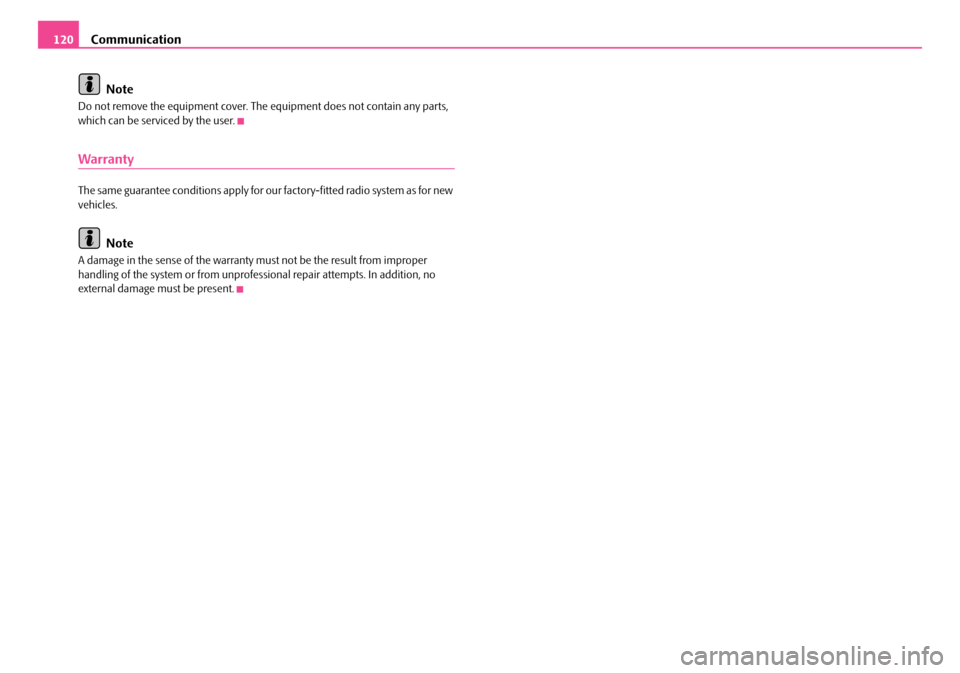
Communication120
Note
Do not remove the equipment cover. The equipment does not contain any parts, which can be serviced by the user.
Warranty
The same guarantee conditions apply for our factory-fitted radio system as for new vehicles.
Note
A damage in the sense of the warranty must not be the result from improper handling of the system or from unprofessional repair attempts. In addition, no external damage must be present.
NKO A05F 20.book Page 120 Wednesday, April 2, 2008 1:02 PM
Page 131 of 252
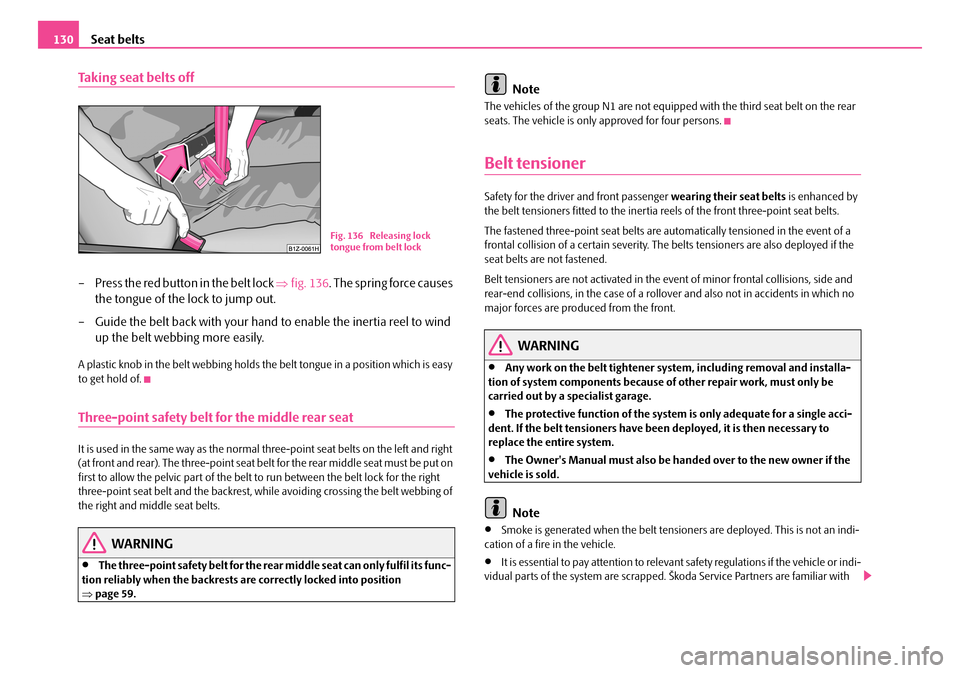
Seat belts130
Taking seat belts off
– Press the red button in the belt lock ⇒fig. 136. The spring force causes
the tongue of the lock to jump out.
– Guide the belt back with your hand to enable the inertia reel to wind
up the belt webbing more easily.
A plastic knob in the belt webbing holds the belt tongue in a position which is easy to get hold of.
Three-point safety belt for the middle rear seat
It is used in the same way as the normal three-point seat belts on the left and right (at front and rear). The three-point seat belt for the rear middle seat must be put on first to allow the pelvic part of the belt to run between the belt lock for the right three-point seat belt and the backrest, while avoiding crossing the belt webbing of the right and middle seat belts.
WARNING
•The three-point safety belt for the rear middle seat can only fulfil its func-tion reliably when the backrests are correctly locked into position ⇒page 59.
Note
The vehicles of the group N1 are not equipped with the third seat belt on the rear seats. The vehicle is only approved for four persons.
Belt tensioner
Safety for the driver and front passenger wearing their seat belts is enhanced by the belt tensioners fitted to the inertia reels of the front three-point seat belts.
The fastened three-point seat belts are automatically tensioned in the event of a frontal collision of a certain severity. The belts tensioners are also deployed if the seat belts are not fastened.
Belt tensioners are not activated in the event of minor frontal collisions, side and rear-end collisions, in the case of a rollover and also not in accidents in which no major forces are produced from the front.
WARNING
•Any work on the belt tightener system, including removal and installa-tion of system components because of other repair work, must only be carried out by a specialist garage.
•The protective function of the system is only adequate for a single acci-dent. If the belt tensioners have been deployed, it is then necessary to replace the entire system.
•The Owner's Manual must also be handed over to the new owner if the vehicle is sold.
Note
•Smoke is generated when the belt tensioners are deployed. This is not an indi-cation of a fire in the vehicle.
•It is essential to pay attention to relevant safety regulations if the vehicle or indi-vidual parts of the system are scrapped. Škoda Service Partners are familiar with
Fig. 136 Releasing lock tongue from belt lock
NKO A05F 20.book Page 130 Wednesday, April 2, 2008 1:02 PM
Page 133 of 252
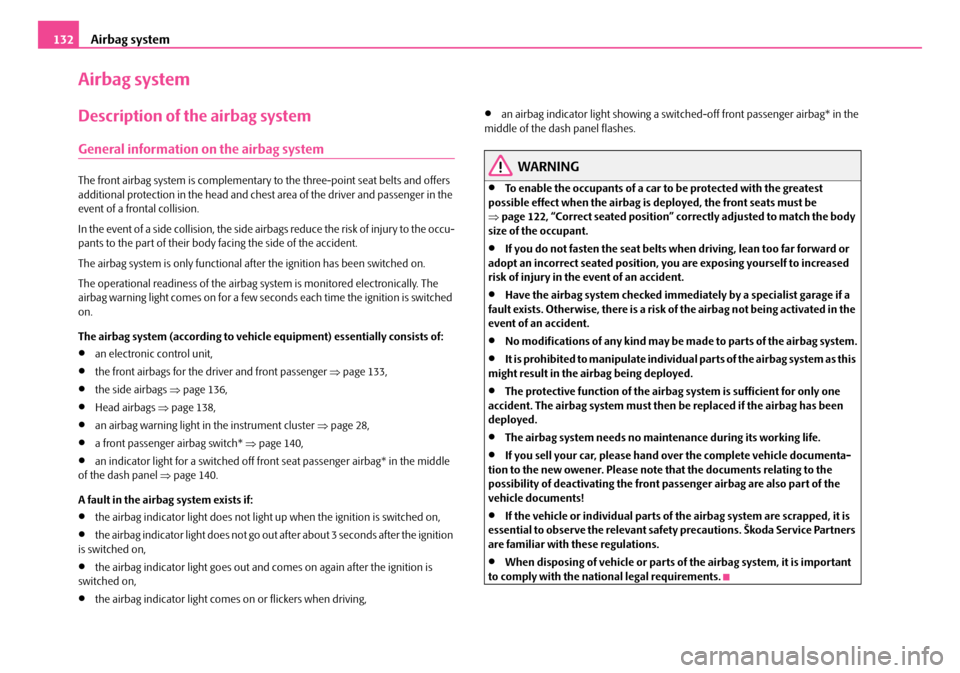
Airbag system132
Airbag system
Description of the airbag system
General information on the airbag system
The front airbag system is complementary to the three-point seat belts and offers additional protection in the head and chest area of the driver and passenger in the event of a frontal collision.
In the event of a side collision, the side airbags reduce the risk of injury to the occu-pants to the part of their body facing the side of the accident.
The airbag system is only functional after the ignition has been switched on.
The operational readiness of the airbag system is monitored electronically. The airbag warning light comes on for a few seconds each time the ignition is switched on.
The airbag system (according to vehicle equipment) essentially consists of:
•an electronic control unit,
•the front airbags for the driver and front passenger ⇒page 133,
•the side airbags ⇒page 136,
•Head airbags ⇒page 138,
•an airbag warning light in the instrument cluster ⇒page 28,
•a front passenger airbag switch* ⇒page 140,
•an indicator light for a switched off front seat passenger airbag* in the middle of the dash panel ⇒page 140.
A fault in the airbag system exists if:
•the airbag indicator light does not light up when the ignition is switched on,
•the airbag indicator light does not go out after about 3 seconds after the ignition is switched on,
•the airbag indicator light goes out and comes on again after the ignition is switched on,
•the airbag indicator light comes on or flickers when driving,
•an airbag indicator light showing a switched-off front passenger airbag* in the middle of the dash panel flashes.
WARNING
•To enable the occupants of a car to be protected with the greatest possible effect when the airbag is deployed, the front seats must be ⇒page 122, “Correct seated position” correctly adjusted to match the body size of the occupant.
•If you do not fasten the seat belts when driving, lean too far forward or adopt an incorrect seated position, you are exposing yourself to increased risk of injury in the event of an accident.
•Have the airbag system checked immediately by a specialist garage if a fault exists. Otherwise, there is a risk of the airbag not being activated in the event of an accident.
•No modifications of any kind may be made to parts of the airbag system.
•It is prohibited to manipulate individual parts of the airbag system as this might result in the airbag being deployed.
•The protective function of the airbag system is sufficient for only one accident. The airbag system must then be replaced if the airbag has been deployed.
•The airbag system needs no maintenance during its working life.
•If you sell your car, please hand over the complete vehicle documenta-tion to the new owener. Please note that the documents relating to the possibility of deactivating the front passenger airbag are also part of the vehicle documents!
•If the vehicle or individual parts of the airbag system are scrapped, it is essential to observe the relevant safety precautions. Škoda Service Partners are familiar with these regulations.
•When disposing of vehicle or parts of the airbag system, it is important to comply with the national legal requirements.
NKO A05F 20.book Page 132 Wednesday, April 2, 2008 1:02 PM
Page 141 of 252
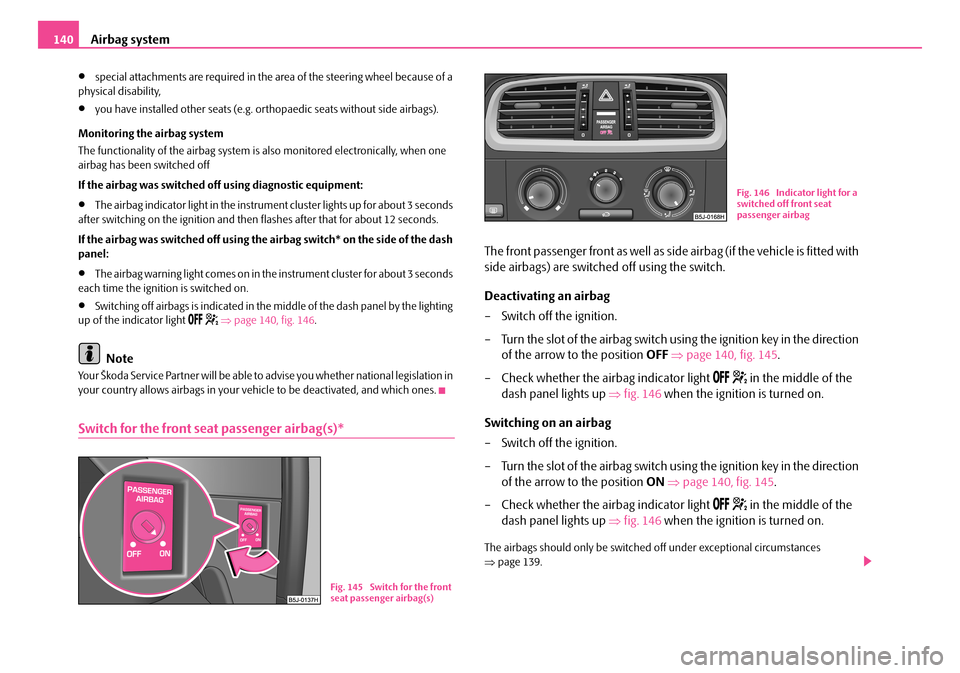
Airbag system140
•special attachments are required in the area of the steering wheel because of a physical disability,
•you have installed other seats (e.g. orthopaedic seats without side airbags).
Monitoring the airbag system
The functionality of the airbag system is also monitored electronically, when one airbag has been switched off
If the airbag was switched off using diagnostic equipment:
•The airbag indicator light in the instrument cluster lights up for about 3 seconds after switching on the ignition and then flashes after that for about 12 seconds.
If the airbag was switched off using the airbag switch* on the side of the dash panel:
•The airbag warning light comes on in the instrument cluster for about 3 seconds each time the ignition is switched on.
•Switching off airbags is indicated in the middle of the dash panel by the lighting up of the indicator light ⇒page 140, fig. 146.
Note
Your Škoda Service Partner will be able to advise you whether national legislation in your country allows airbags in your vehicle to be deactivated, and which ones.
Switch for the front seat passenger airbag(s)*
The front passenger front as well as side airbag (if the vehicle is fitted with
side airbags) are switched off using the switch.
Deactivating an airbag
– Switch off the ignition.
– Turn the slot of the airbag switch using the ignition key in the direction
of the arrow to the position OFF ⇒page 140, fig. 145.
– Check whether the airbag indicator light in the middle of the
dash panel lights up ⇒fig. 146 when the ignition is turned on.
Switching on an airbag
– Switch off the ignition.
– Turn the slot of the airbag switch using the ignition key in the direction
of the arrow to the position ON ⇒page 140, fig. 145.
– Check whether the airbag indicator light in the middle of the
dash panel lights up ⇒fig. 146 when the ignition is turned on.
The airbags should only be switched off under exceptional circumstances ⇒page 139.
Fig. 145 Switch for the front seat passenger airbag(s)
Fig. 146 Indicator light for a switched off front seat passenger airbag
NKO A05F 20.book Page 140 Wednesday, April 2, 2008 1:02 PM
Page 149 of 252
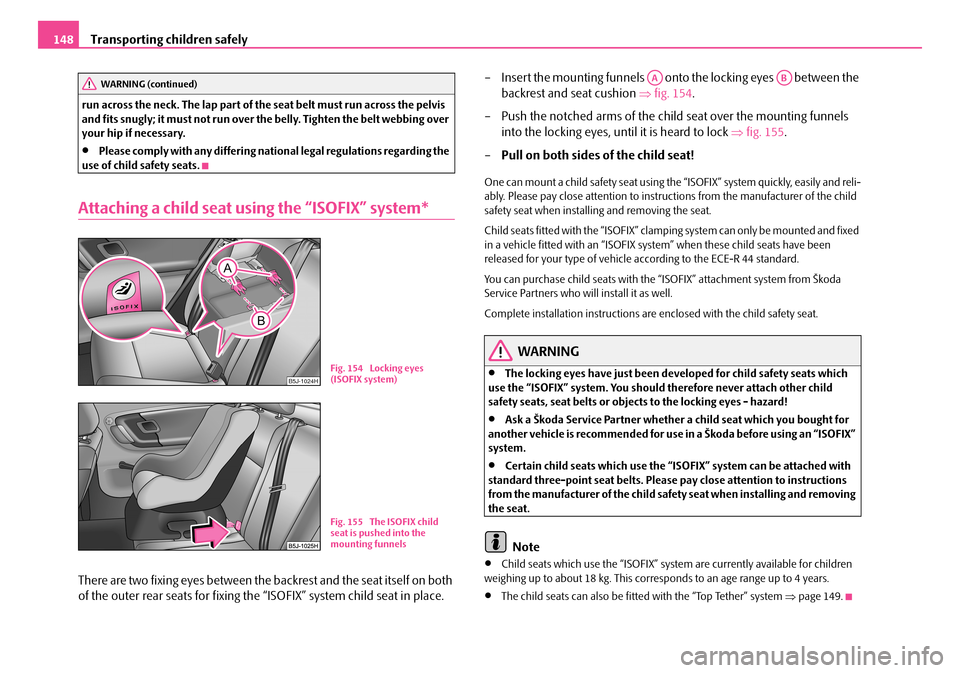
Transporting children safely148
run across the neck. The lap part of the seat belt must run across the pelvis and fits snugly; it must not run over the belly. Tighten the belt webbing over your hip if necessary.
•Please comply with any differing national legal regulations regarding the use of child safety seats.
Attaching a child seat using the “ISOFIX” system*
There are two fixing eyes between the backrest and the seat itself on both
of the outer rear seats for fixing the “ISOFIX” system child seat in place.
– Insert the mounting funnels onto the locking eyes between the
backrest and seat cushion ⇒fig. 154.
– Push the notched arms of the child seat over the mounting funnels
into the locking eyes, until it is heard to lock ⇒fig. 155.
–Pull on both sides of the child seat!
One can mount a child safety seat using the “ISOFIX” system quickly, easily and reli-ably. Please pay close attention to instructions from the manufacturer of the child safety seat when installing and removing the seat.
Child seats fitted with the “ISOFIX” clamping system can only be mounted and fixed in a vehicle fitted with an “ISOFIX system” when these child seats have been released for your type of vehicle according to the ECE-R 44 standard.
You can purchase child seats with the “ISOFIX” attachment system from Škoda Service Partners who will install it as well.
Complete installation instructions are enclosed with the child safety seat.
WARNING
•The locking eyes have just been developed for child safety seats which use the “ISOFIX” system. You should therefore never attach other child safety seats, seat belts or objects to the locking eyes - hazard!
•Ask a Škoda Service Partner whether a child seat which you bought for another vehicle is recommended for use in a Škoda before using an “ISOFIX” system.
•Certain child seats which use the “ISOFIX” system can be attached with standard three-point seat belts. Please pay close attention to instructions from the manufacturer of the child safety seat when installing and removing the seat.
Note
•Child seats which use the “ISOFIX” system are currently available for children weighing up to about 18 kg. This corresponds to an age range up to 4 years.
•The child seats can also be fitted with the “Top Tether” system ⇒page 149.
WARNING (continued)
B5J-1024HFig. 154 Locking eyes (ISOFIX system)
Fig. 155 The ISOFIX child seat is pushed into the mounting funnels
AAAB
NKO A05F 20.book Page 148 Wednesday, April 2, 2008 1:02 PM
Page 155 of 252
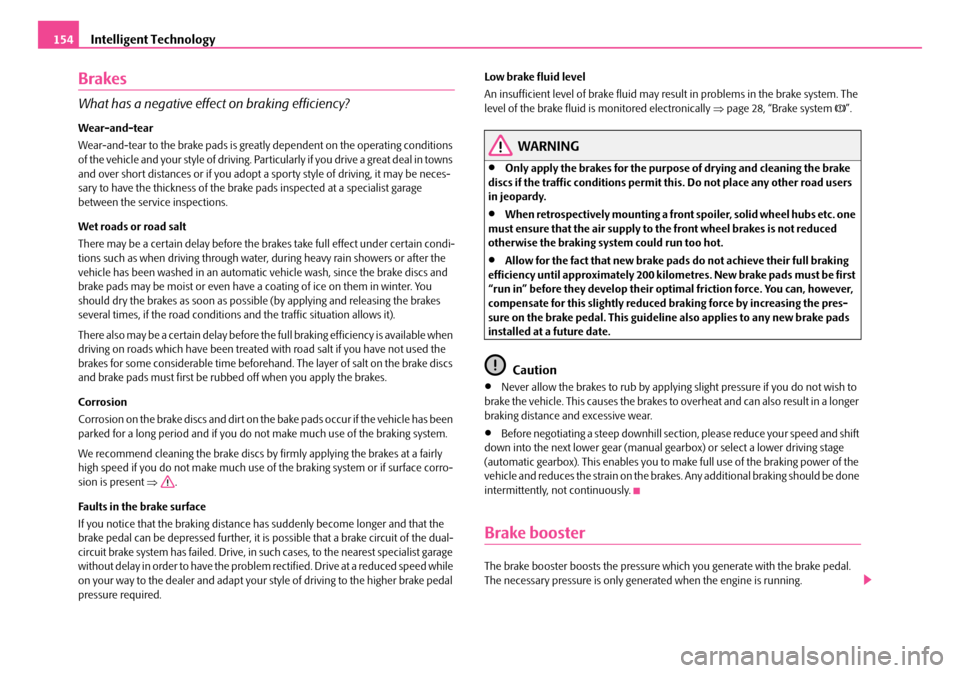
Intelligent Technology154
Brakes
What has a negative effect on braking efficiency?
Wear-and-tear
Wear-and-tear to the brake pads is greatly dependent on the operating conditions of the vehicle and your style of driving. Particularly if you drive a great deal in towns and over short distances or if you adopt a sporty style of driving, it may be neces-sary to have the thickness of the brake pads inspected at a specialist garage between the service inspections.
Wet roads or road salt
There may be a certain delay before the brakes take full effect under certain condi-tions such as when driving through water, during heavy rain showers or after the vehicle has been washed in an automatic vehicle wash, since the brake discs and brake pads may be moist or even have a coating of ice on them in winter. You should dry the brakes as soon as possible (by applying and releasing the brakes several times, if the road conditions and the traffic situation allows it).
There also may be a certain delay before the full braking efficiency is available when driving on roads which have been treated with road salt if you have not used the brakes for some considerable time beforehand. The layer of salt on the brake discs and brake pads must first be rubbed off when you apply the brakes.
Corrosion
Corrosion on the brake discs and dirt on the bake pads occur if the vehicle has been parked for a long period and if you do not make much use of the braking system.
We recommend cleaning the brake discs by firmly applying the brakes at a fairly high speed if you do not make much use of the braking system or if surface corro-sion is present ⇒.
Faults in the brake surface
If you notice that the braking distance has suddenly become longer and that the brake pedal can be depressed further, it is possible that a brake circuit of the dual-circuit brake system has failed. Drive, in such cases, to the nearest specialist garage without delay in order to have the problem rectified. Drive at a reduced speed while on your way to the dealer and adapt your style of driving to the higher brake pedal pressure required.
Low brake fluid level
An insufficient level of brake fluid may result in problems in the brake system. The level of the brake fluid is monitored electronically ⇒page 28, “Brake system ”.
WARNING
•Only apply the brakes for the purpose of drying and cleaning the brake discs if the traffic conditions permit this. Do not place any other road users in jeopardy.
•When retrospectively mounting a front spoiler, solid wheel hubs etc. one must ensure that the air supply to the front wheel brakes is not reduced otherwise the braking system could run too hot.
•Allow for the fact that new brake pads do not achieve their full braking efficiency until approximately 200 kilometres. New brake pads must be first “run in” before they develop their optimal friction force. You can, however, compensate for this slightly reduced braking force by increasing the pres-sure on the brake pedal. This guideline also applies to any new brake pads installed at a future date.
Caution
•Never allow the brakes to rub by applying slight pressure if you do not wish to brake the vehicle. This causes the brakes to overheat and can also result in a longer braking distance and excessive wear.
•Before negotiating a steep downhill section, please reduce your speed and shift down into the next lower gear (manual gearbox) or select a lower driving stage (automatic gearbox). This enables you to make full use of the braking power of the vehicle and reduces the strain on the brakes. Any additional braking should be done intermittently, not continuously.
Brake booster
The brake booster boosts the pressure which you generate with the brake pedal. The necessary pressure is only generated when the engine is running.
NKO A05F 20.book Page 154 Wednesday, April 2, 2008 1:02 PM
Page 159 of 252
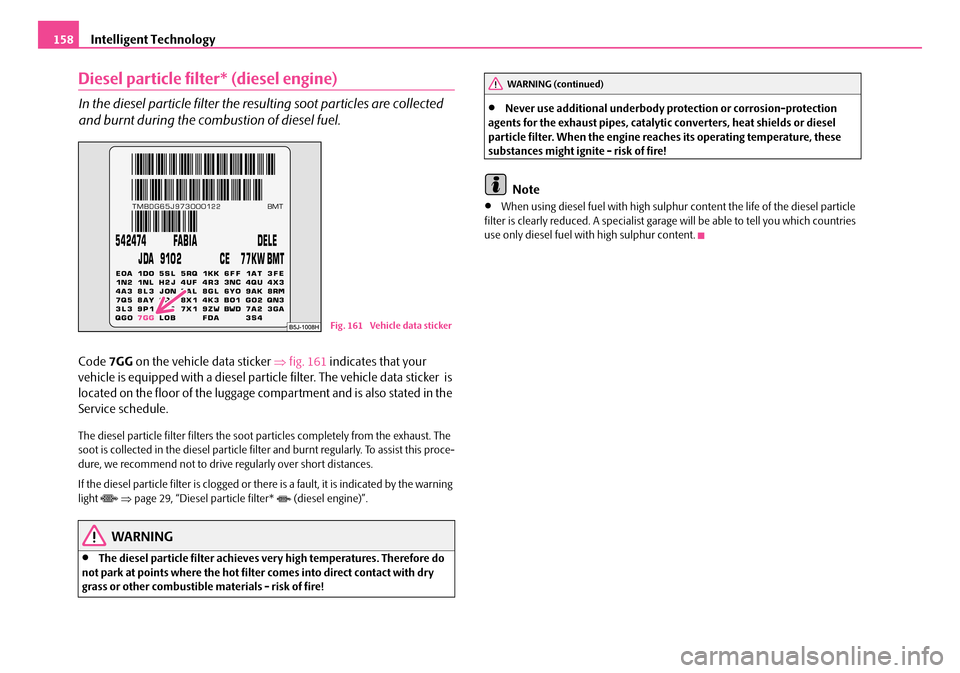
Intelligent Technology158
Diesel particle filter* (diesel engine)
In the diesel particle filter the resulting soot particles are collected
and burnt during the combustion of diesel fuel.
Code 7GG on the vehicle data sticker ⇒fig. 161 indicates that your
vehicle is equipped with a diesel particle filter. The vehicle data sticker is
located on the floor of the luggage compartment and is also stated in the
Service schedule.
The diesel particle filter filters the soot particles completely from the exhaust. The soot is collected in the diesel particle filter and burnt regularly. To assist this proce-dure, we recommend not to drive regularly over short distances.
If the diesel particle filter is clogged or there is a fault, it is indicated by the warning light ⇒page 29, “Diesel particle filter* (diesel engine)”.
WARNING
•The diesel particle filter achieves very high temperatures. Therefore do not park at points where the hot filter comes into direct contact with dry grass or other combustible materials - risk of fire!
•Never use additional underbody protection or corrosion-protection agents for the exhaust pipes, catalytic converters, heat shields or diesel particle filter. When the engine reaches its operating temperature, these substances might ignite - risk of fire!
Note
•When using diesel fuel with high sulphur content the life of the diesel particle filter is clearly reduced. A specialist garage will be able to tell you which countries use only diesel fuel with high sulphur content.
Fig. 161 Vehicle data sticker
WARNING (continued)
NKO A05F 20.book Page 158 Wednesday, April 2, 2008 1:02 PM
Page 163 of 252
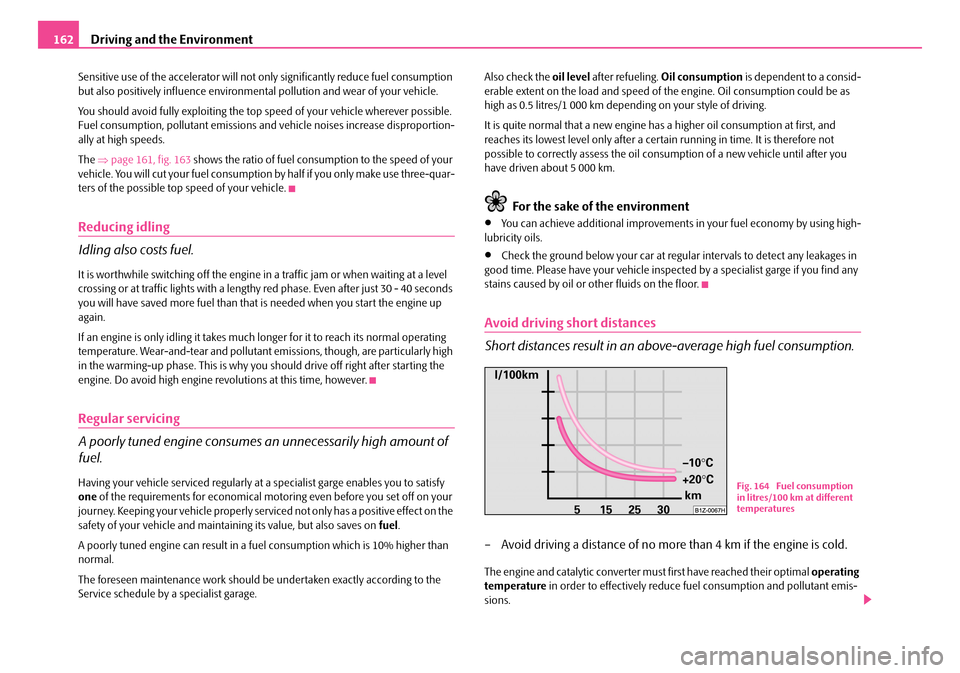
Driving and the Environment162
Sensitive use of the accelerator will not only significantly reduce fuel consumption but also positively influence environmental pollution and wear of your vehicle.
You should avoid fully exploiting the top speed of your vehicle wherever possible. Fuel consumption, pollutant emissions and vehicle noises increase disproportion-ally at high speeds.
The ⇒page 161, fig. 163 shows the ratio of fuel consumption to the speed of your vehicle. You will cut your fuel consumption by half if you only make use three-quar-ters of the possible top speed of your vehicle.
Reducing idling
Idling also costs fuel.
It is worthwhile switching off the engine in a traffic jam or when waiting at a level crossing or at traffic lights with a lengthy red phase. Even after just 30 - 40 seconds you will have saved more fuel than that is needed when you start the engine up again.
If an engine is only idling it takes much longer for it to reach its normal operating temperature. Wear-and-tear and pollutant emissions, though, are particularly high in the warming-up phase. This is why you should drive off right after starting the engine. Do avoid high engine revolutions at this time, however.
Regular servicing
A poorly tuned engine consumes an unnecessarily high amount of
fuel.
Having your vehicle serviced regularly at a specialist garge enables you to satisfy one of the requirements for economical motoring even before you set off on your journey. Keeping your vehicle properly serviced not only has a positive effect on the safety of your vehicle and maintaining its value, but also saves on fuel.
A poorly tuned engine can result in a fuel consumption which is 10% higher than normal.
The foreseen maintenance work should be undertaken exactly according to the Service schedule by a specialist garage.
Also check the oil level after refueling. Oil consumption is dependent to a consid-erable extent on the load and speed of the engine. Oil consumption could be as high as 0.5 litres/1 000 km depending on your style of driving.
It is quite normal that a new engine has a higher oil consumption at first, and reaches its lowest level only after a certain running in time. It is therefore not possible to correctly assess the oil consumption of a new vehicle until after you have driven about 5 000 km.
For the sake of the environment
•You can achieve additional improvements in your fuel economy by using high-lubricity oils.
•Check the ground below your car at regular intervals to detect any leakages in good time. Please have your vehicle inspected by a specialist garge if you find any stains caused by oil or other fluids on the floor.
Avoid driving short distances
Short distances result in an above-average high fuel consumption.
– Avoid driving a distance of no more than 4 km if the engine is cold.
The engine and catalytic converter must first have reached their optimal operating temperature in order to effectively reduce fuel consumption and pollutant emis-sions.
Fig. 164 Fuel consumption in litres/100 km at different temperatures
NKO A05F 20.book Page 162 Wednesday, April 2, 2008 1:02 PM
Page 165 of 252

Driving and the Environment164
•Minimum fuel leakage during accidents
•Reduced noise
Choice of materials
•extensive use of recyclable material
•Air conditioning filled with CFC-free refrigerant
•no cadmium
•no asbestos
•Reduction in the “vaporisation” of plastics
Manufacture
•solvent-free cavity protection
•solvent-free protection of the vehicle for transportation from the production plant to the customer
•The use of solvent-free adhesives
•No CFCs used in the production process
•without use of mercury
•Use of water-soluble paints
•no use of hexavalent chromium
Trade-in and recycling of old cars
Škoda Auto meets the requirements of the brand and its products regarding envi-ronment and ressource protection. All new Škoda vehicles can be utilized up to 95 % and always 5) be returned. In a lot of countries sufficient trade-in networks have been created, where you can trade-in your vehicle. After you trade-in your vehicle, you will receive a confirmation stating the recycling in accordance with environmental regulations.
Vehicles with special built-on types
Technical documents regarding changes carried out on the vehicle must be kept by the vehicle user, in order to hand over later to the old car user. This ensures the recycling in accordance with environmental regulations.
Note
Detailed information about the trade-in and recycling of old cars is available from your Škoda Service Partner.
Motoring abroad
General
Other circumstances may exist abroad.
It is also possible, in certain countries, that the Škoda Service Partner network is limited or has not been established yet. This is the reason why obtaining certain spare parts may be somewhat complicated and specialist garage personnel may only be able to ma ke li mite d re pa irs. Škoda Auto a.s. i n the Czech Republic and rele -vant importers are happy to provide information about technical aspects of the vehicle, required maintenance work and possibilities for getting repairs done.
Unleaded petrol
A vehicle fitted with a petrol engine must always be refuelled with unleaded petrol ⇒page 160. The automobile associations can provide you with information regarding the locations of filling stations which offer unleaded petrol.
Headlights
The low beam of your headlights is set asymmetrically. It illuminates the side of the road on which you are driving to a greater extent. If you drive abroad on the other side of the road, you will dazzle oncoming traffic.
It is necessary in order to avoid dazzling oncoming traffic to stick a sticker over a certain part of the headlights.
Headlight stickers can be obtained as a spare part from the Skoda Service Partners.
Headlights with module are designed for driving in countries with traffic on the right or on the left. Have this done always at a Škoda Service Partner.5)subject to fulfilment of the national legal regulations
NKO A05F 20.book Page 164 Wednesday, April 2, 2008 1:02 PM
Page 166 of 252

Driving and the Environment165
Using the systemSafetyDriving TipsGeneral MaintenanceBreakdown assistanceTechnical Data
Note
You can obtain further information regarding masking over or converting the head-lights from your Škoda Service Partner.
Avoiding damage to your vehicle
When driving on poor roads and lanes or when driving over kerbstones, steep ramps etc., you must pay particular attention to ensuring that any low-slung parts of the vehicle, such as spoiler and exhaust, do not touch the ground and get damaged.
This particularly applies to models with a lowered suspension (sport suspension) and also when your vehicle is fully laden.
NKO A05F 20.book Page 165 Wednesday, April 2, 2008 1:02 PM